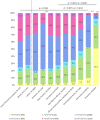CYP2C19 Gene Profiling as a Tool for Personalized Stress Ulcer Prophylaxis With Proton Pump Inhibitors in Critically Ill Patients - Recommendations Proposal
- PMID: 35899207
- PMCID: PMC9309431
- DOI: 10.3389/fmed.2022.854280
CYP2C19 Gene Profiling as a Tool for Personalized Stress Ulcer Prophylaxis With Proton Pump Inhibitors in Critically Ill Patients - Recommendations Proposal
Abstract
To this date, there are no recommendations for personalized stress ulcer prophylaxis (SUP) in critical care that would take the patient's individual genetic predispositions into account. Of drugs used for this purpose, proton pump inhibitors (PPIs) are the first-choice drugs in intensive care unit patients. The degradation of proton pump inhibitors is mediated by cytochrome P450 (CYP) enzymes; in particular, CYP2C19 and, to a lesser extent, CYP3A4 are involved. Expression and metabolic activity of, namely in, CYP2C19 is significantly affected by single nucleotide polymorphisms, the drug metabolization rate varies greatly from ultrarapid to poor and likely influences the optimal dosage. As these CYP2C19 predictive phenotypes via CYP2C19 haplogenotypes (rs12248560/rs4244285) can be relatively easily determined using the current standard equipment of hospital laboratories, we prepared a set of recommendations for personalized PPI-based stress ulcer prophylaxis taking into account the patient's CYP2C19 predictive phenotype determined in this way. These recommendations are valid, in particular, for European, American and African populations, because these populations have the high representations of the CYP2C19*17 allele associated with the overexpression of the CYP2C19 gene and ultrarapid degradation of PPIs. We propose the CYP2C19 gene profiling as a tool for personalized SUP with PPI in critically ill patients.
Keywords: critical care; gene polymorphism; personalized therapy; pharmacogenetics; poor metabolizer; proton pump inhibitors; stress ulcer prophylaxis; ultra-rapid metabolizer.
Copyright © 2022 Bořilová Linhartová, Zendulka, Janošek, Mlčůchová, Cvanová, Daněk, Kroupa, Bartošová and Lipový.
Conflict of interest statement
The authors declare that the research was conducted in the absence of any commercial or financial relationships that could be construed as a potential conflict of interest.
Figures

Similar articles
-
The frequency of CYP2C19 genetic polymorphisms in Russian patients with peptic ulcers treated with proton pump inhibitors.Pharmgenomics Pers Med. 2015 May 27;8:111-4. doi: 10.2147/PGPM.S78986. eCollection 2015. Pharmgenomics Pers Med. 2015. PMID: 26109874 Free PMC article.
-
CYP3A and CYP2C19 activity in urine in relation to CYP3A4, CYP3A5, and CYP2C19 polymorphisms in Russian peptic ulcer patients taking omeprazole.Pharmgenomics Pers Med. 2018 Jun 18;11:107-112. doi: 10.2147/PGPM.S159708. eCollection 2018. Pharmgenomics Pers Med. 2018. PMID: 29950882 Free PMC article.
-
Genetic polymorphism of CYP2C19 & therapeutic response to proton pump inhibitors.Indian J Med Res. 2008 Jun;127(6):521-30. Indian J Med Res. 2008. PMID: 18765869 Review.
-
Effects of Genetic Polymorphisms of Cytochrome P450 Enzymes and MDR1 Transporter on Pantoprazole Metabolism and Helicobacter pylori Eradication.Basic Clin Pharmacol Toxicol. 2017 Feb;120(2):199-206. doi: 10.1111/bcpt.12667. Epub 2016 Nov 2. Basic Clin Pharmacol Toxicol. 2017. PMID: 27611887
-
CYP2C19 polymorphism influences Helicobacter pylori eradication.World J Gastroenterol. 2014 Nov 21;20(43):16029-36. doi: 10.3748/wjg.v20.i43.16029. World J Gastroenterol. 2014. PMID: 25473155 Free PMC article. Review.
Cited by
-
Proton Pump Inhibitor Usage in Urban vs. Rural Intensive Care Units: A Narrative Review of Implications for Standardization of Care.Cureus. 2024 Oct 14;16(10):e71446. doi: 10.7759/cureus.71446. eCollection 2024 Oct. Cureus. 2024. PMID: 39539851 Free PMC article. Review.
-
Clinical Implications of Proton Pump Inhibitors and Vonoprazan Micro/Nano Drug Delivery Systems for Gastric Acid-Related Disorders and Imaging.Nanotheranostics. 2024 Sep 30;8(4):535-560. doi: 10.7150/ntno.100727. eCollection 2024. Nanotheranostics. 2024. PMID: 39507107 Free PMC article. Review.
References
LinkOut - more resources
Full Text Sources
Research Materials

